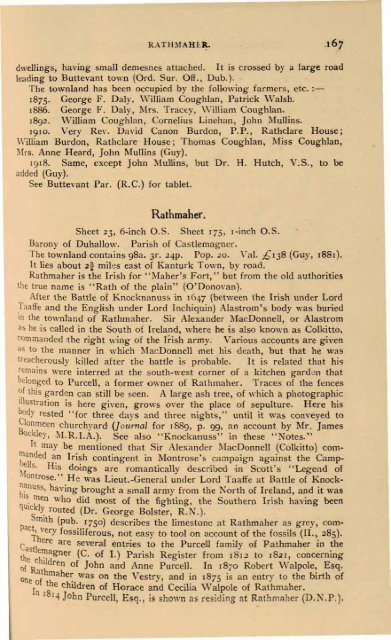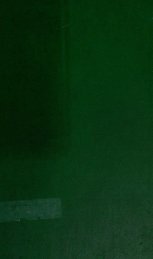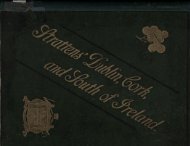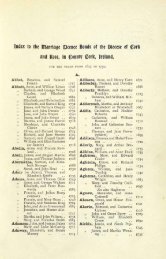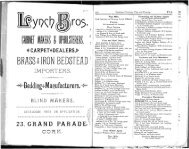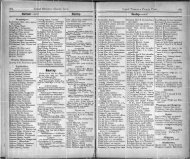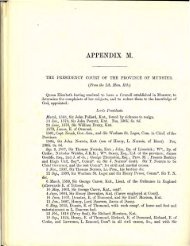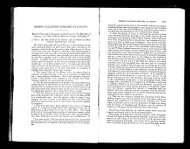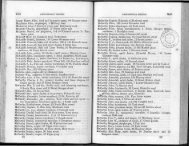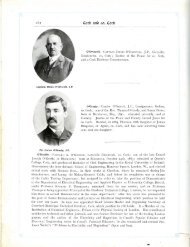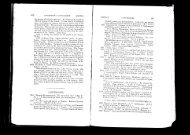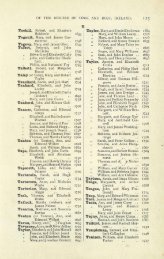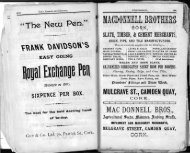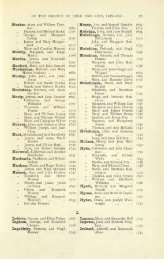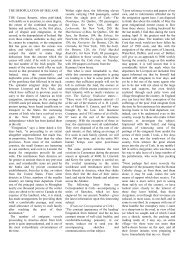Rathmaher. - Cork Past and Present
Rathmaher. - Cork Past and Present
Rathmaher. - Cork Past and Present
You also want an ePaper? Increase the reach of your titles
YUMPU automatically turns print PDFs into web optimized ePapers that Google loves.
RATHMAHER. 167<br />
dwellings, having small demesnes attached. It is crossed by a large road<br />
leading to Buttevant town (Ord. Sur. Off., Dub.).<br />
The townl<strong>and</strong> has been occupied by the following farmers, etc. :<br />
1875. George F. Daly. William Coughlan, Patrick Walsh.<br />
1886. George F. Daly, Mrs. Tracey, William Coughlan.<br />
1892. William Coughlan, Cornelius Linehan, John Mullins.<br />
1910. Very Rev. David Canon Burden, P.P., Rathclare House;<br />
William Burdon, Rathclare House; Thomas Coughlan, Miss Coughlan,<br />
Mrs. Anne Heard, John Mullins (Guy).<br />
1918. Same, except John Mulins, but Dr. H. Hutch, V.S., to be<br />
added (Guy).<br />
See Buttevant Par. (R.C.) for tablet.<br />
<strong>Rathmaher</strong>.<br />
Sheet 2$, 6-inch O.S. Sheet 175, i-inch O.S. %<br />
Barony of Duhallow. Parish of Castlemagner.<br />
The townl<strong>and</strong> contains 98a. 3r. 24p. Pop. 20. Val. ^138 (Guy, 1881).<br />
It lies about 2J miles east of Kanturk Town, by road.<br />
<strong>Rathmaher</strong> is the Irish for "Maker's Fort," but from the old authorities<br />
the true name is "Rath of the plain" (O'Donovan).<br />
After the Battle of Knocknanuss in 1647 (between the Irish under Lord<br />
Taaffe <strong>and</strong> the English under Lord Inchiquin) Alastrom's body was buried<br />
»n the townl<strong>and</strong> of <strong>Rathmaher</strong>. Sir Alex<strong>and</strong>er MacDonnell, or Alastrom<br />
as he is called in the South of Irel<strong>and</strong>, where he is also known as Colkitto,<br />
comm<strong>and</strong>ed the right wing of the Irish army. Various -accounts are given<br />
as to the manner in which MacDonnell met his death, but that he was<br />
treacherously killed after the battle is probable. It is related that his<br />
remains were interred at the south-west corner of a kitchen garden that<br />
belonged to Purcell, a former owner of <strong>Rathmaher</strong>. Traces of the fences<br />
°f this garden can still be seen. A large ash tree, of which a photographic<br />
"lustration is here given, grows over the place of sepulture. Here his<br />
body rested "for three days <strong>and</strong> three nights," until it was conveyed to<br />
Uonmeen churchyard (Journal for 1889, p. 99, an account by Mr. James<br />
Buckley, M.R.I.A.). See also "Knockamuss" in these "Notes."<br />
It may be mentioned that Sir Alex<strong>and</strong>er MacDonnell (Colkitto) com<strong>and</strong>ed<br />
an Irish contingent in Montrose's campaign against the Campus.<br />
His doings are romantically described in Scott's "Legend of<br />
^ontrose." He was Lieut.-General under Lord Taaffe at Battle of Knocknuss,<br />
having brought a small army from the North of Irel<strong>and</strong>, <strong>and</strong> it was<br />
nien who did most of the fighting, the Southern Irish having been<br />
Sickly routed (Dr. George Bolster, R.N.).<br />
Da . m (pub. 1750) describes the limestone at <strong>Rathmaher</strong> as grey, com-<br />
°Th Very fossiIiferous > not easy to tool on account of the fossils (II., 285).<br />
Ca t\ are several en *ries to the Purcell family of <strong>Rathmaher</strong> an the<br />
the t^ gner ^ C * of L ) Parish Register from 1812 to 1821, concerning<br />
of R°*7 dren of John <strong>and</strong> Anne Purcell. In 1870 Robert Walpole, Esq.<br />
one a « t T laher was on the Vestry, <strong>and</strong> in 1875 is an entry to the birth of<br />
* ot the children of Horace <strong>and</strong> Cecilia Walpole of <strong>Rathmaher</strong>.<br />
n l8l 4 John Purcell, Esq., is shown as residing at <strong>Rathmaher</strong> (D.N.P.).<br />
rtft
168 HISTORICAL AND TOPOGRAPHICAL NOTES.<br />
Lewis (pub. 1837) gives C. Purcell as living at <strong>Rathmaher</strong> (I. 303, under<br />
Castlemagner).<br />
- The Field Book of 1840 states:—"<strong>Rathmaher</strong>, a small townl<strong>and</strong>, all<br />
demesne. Contains a gentleman's seat <strong>and</strong> has a stream on each side.<br />
Occupied by Denroche Purcell, Esq."<br />
<strong>Rathmaher</strong> House. There is a pond here named "Chieftain's Pond,"<br />
so called from a chieftain or chief of the Irish army, who was killed here<br />
on his retreat from the Battle of Knocknanuss by a man named "Samuels,"<br />
some of the latter's offspring are still inhabitants convenient to this place<br />
Ord. Sur Off., Dub.).<br />
Elizabeth, eldest daughter of George Bolster of Curraghbower, married<br />
Robert Walpole of <strong>Rathmaher</strong> (see Curraghbower in these "Notes").<br />
The following appear to have lived at <strong>Rathmaher</strong>:—<br />
1855. Robert Walpole (Dr. Geo. Bolster, R.N.).<br />
1875. Robert Walpole.<br />
1886. Robert Walpole.<br />
1892. Michael Smith (Guy).<br />
In May, 1909, I visited <strong>Rathmaher</strong> <strong>and</strong> had a conversation with the<br />
owner, Mr. Michael Smith, who informed me that he came to <strong>Rathmaher</strong><br />
in 1890, having succeeded Mrs. Neale, who was here for a few years.<br />
It appears that Mr. Neale had married a daughter of Mr. Robert Walpole<br />
of <strong>Rathmaher</strong>, <strong>and</strong> it was from her, as a widow, that Mr. Smith purchased<br />
the interest lin the place.. He lives here still (11918).<br />
iMr. Joseph Gubbins of Dunkettle was the l<strong>and</strong>lord, who succeeded<br />
the Wises. Mr. M. Smith purchased the property under the L<strong>and</strong> Pur<br />
chase Act of 1903. He informed me that a branch of the Purcell family<br />
had lived here <strong>and</strong> built the house <strong>and</strong> walls round the demesne.<br />
Mr. Smith came from Knockardrahan, in the parish of Dromtarift,<br />
about 2\ miles west of Kanturk.<br />
John, 2nd son of Sir John Purcell, "Knight of the Knife," is described<br />
«w. - "<br />
as of <strong>Rathmaher</strong>, in the pedigree of Purcell of Burton (see these "Notes,<br />
I-, 333). ,<br />
William Purcell, Esq. of <strong>Rathmaher</strong> was buried in Kilbrin Churchyard,<br />
3 May, 1833 (Kilbriin C. of I. Parish Register).<br />
Mr. G. Sharpe Bolster, J.P. of Glenmount, Kanturk, writes 15 April,<br />
1910:—"<strong>Rathmaher</strong> House was built by the renowned Sir John Puree!<br />
of Highfort fame, labout 120 years ago. His gr<strong>and</strong>son, the late Charles<br />
Denroche Purcell lived at <strong>Rathmaher</strong> from about 1810 to 1850, when he<br />
died. The late Robert Walpode, ia gentleman of Queen's County birth <strong>and</strong><br />
family, resided at <strong>Rathmaher</strong> from about 1850 to 1852, to the time of his<br />
death in 1886. It is a fine farm, well <strong>and</strong> ornamentaly planted, <strong>and</strong> t e<br />
house a fairly good one. There as a large wall surroundng portion or<br />
l<strong>and</strong>, the work of the late Charles Purcell."<br />
Dr. George Bolster, R.N., writes 1910:—"The acreage is more than<br />
double that shown under the denomination <strong>Rathmaher</strong>, as Sir John Pure<br />
purchased part of the neighbouring townl<strong>and</strong> of Ballyheen, <strong>and</strong> incorpora -<br />
it in his demesne. In this part of the place the site of an old eas e<br />
shown, <strong>and</strong> under a causeway leading to lit there was until quite rece ^,;<br />
a very ancient arched bridge over a stream. Hereabouts the la e<br />
Walpole had some drainage operations, <strong>and</strong> in deepening the bed<br />
stream, the workmen threw out large numbers of bones, mostly of no
THE REFUGE, DONERAILE. 169<br />
The quantity was so much that they were sent to Curraghbower to be made<br />
into superphosphate. It is supposed they were the relics of thte Battle of<br />
Knocknanuss."<br />
JOHN PUECELL of <strong>Rathmaher</strong>, 2nd son of Sir John Purcell (see Purcell of Burton.<br />
B. L. Gentry) m. 1807 at St. Ann's Sh<strong>and</strong>on, about 16 May, Anne, dau. of Charles<br />
Denroche of <strong>Cork</strong>, by his wife Anne Dorman (m. 1775), <strong>and</strong> had issue (as shown in the<br />
C. of I. Pat. Beg. of Castlemagner, <strong>and</strong> P.E.O., Irld.)—<br />
I. William, bap. 11 Oct., 1812, died 1834.<br />
II. Charles Denroche b. 1813, bur. 11 Aug., 1850.<br />
III. John, bap. 20 Feb., 1814<br />
IV. Thomas, bap. 24 March, 1815.<br />
V. George Dunscombe, bap. 23 Sept., 1816.<br />
I. Lydia Dunscombe, bap. 12 May, 1818.<br />
II. Martha, bap. 18 Aug., 1819.<br />
III. Mary, bap. 11 March, 1821, d. 1838.<br />
Dr. H. F. Berry, Litt. D., I.S.O., informs me that by the Census<br />
Returns of 1841, Charles Denroche Purcell was living unmarried at <strong>Rathmaher</strong>,<br />
with six servants <strong>and</strong> two visitors. His age states it to be 28, in<br />
which case he was born in 1813.<br />
The following is taken from the Kilbrin C. of I. Par. Regr. :•<br />
Buried 10 Aug., 1823, Anne, dau. of John Purcell of Rannahery<br />
(P<strong>Rathmaher</strong>).<br />
Buried 11 Augt., 1850, Charles Denroche Purcell.<br />
The Refuge (Turnpike House or Clune Bawn) Doneraile.<br />
Sheet 17, 6-inch O.S. (not shown by name, but building indicated).<br />
Sheet 164, i-inch O.S.<br />
Barony of Fermoy Parish of Doneraile.<br />
The Refuge or Turnpike House is a small Cottage about £ mile north<br />
from the bridge over the River Awbeg, at Doneraile Village. It lies in<br />
the S.E. corner of Cloonbane townl<strong>and</strong>, at the junction of the roads, immediately<br />
north of Doneraile village, at the top of the hill.<br />
It was formerly the residence of the Rev. Henry Somerville, Rector of<br />
Aempleroan, *nd Perpetual Curate of Doneraile. He was the author of a<br />
Pamphlet entitled "Donerailiensia," 1850. Also a pamphlet on the<br />
baptismal Suit of Somerville versus Robinson.'' He died hei-e in 1867.<br />
tte was a bachelor, but his sister, Miss Somerville, lived with him. In his<br />
With cotta £ e was call ed "The Refuge," <strong>and</strong> the front was covered<br />
i;o HISTORICAL AND TOPOGRAPHICAL NOTES.<br />
Mrs. Wicks gives her address as "Clune Bawn."<br />
Mr. Percy J. O'Brien, writes 18 Oct., 1910, as follows:—"Before the<br />
Rev. Mr. Somerville went to live in the "Refuge'' or Turnpike House,<br />
which was built by Mr. Fluery, three people lived there, viz., Mr. Hurley,<br />
Jonathan Green, <strong>and</strong> two old ladies named Nagle. Mr. Somerville put a<br />
ver<strong>and</strong>ah round the house <strong>and</strong> did it up. Benjamin Creagh was l<strong>and</strong>lord<br />
<strong>and</strong> gave it to him when Lord Doneraile put him out of the house in which<br />
Father Shinkwin lives at present (1910).<br />
"Mrs. Rosse, wife of Count de Rosse, was daughter of Mr. Henshawe<br />
of Charleville. She was a governess in France <strong>and</strong> married Count de<br />
Rosse, an aged gentleman, who died shortly after, when she inherited his<br />
property, silver, etc.<br />
"In 1896 when the new- school was built, the interior of the "Refuge"<br />
or Turnpike House was remodelled, <strong>and</strong> was occupied by the different<br />
school teachers until 1905."<br />
1881).<br />
F<br />
Renny Castle <strong>and</strong> Townl<strong>and</strong>.<br />
Sheet 34, 6-inch O.S. Sheet 176, i-inch O.S.<br />
Barony of Fermoy. Parish of Kilcummer.<br />
The site of Renny Castle is situated in the townl<strong>and</strong> of Renny Lower.<br />
This townl<strong>and</strong> contains 175a. ir. 24p. Pop. 25. Val. ^205 (Guy,<br />
It lies about 2J miles (by road) S.S.W. of Castletownroche Village,<br />
<strong>and</strong> immediately west of Gonvamore.<br />
Renny is the Irish for "Ferny" (O'Donovan), "a small promontory"<br />
(James Byrne, J.P.).<br />
At the end of a draft book of Orders of the Revenue side of the<br />
Exchequer of the year 1609, is the following entry:—"<strong>Cork</strong>e, Edmonde<br />
Spencer, Kilvrogan, Kilwanton, Backbeliston, Neghwan, Ballintegan,<br />
Rynny, in Conte <strong>Cork</strong>, sp'ualities <strong>and</strong> temp'alities.<br />
Peregrine Spenser, who died in the King's service in the first year 01<br />
the Irish Rebellion, was seized in fee of the castle, town <strong>and</strong> l<strong>and</strong>s ot<br />
Reny, otherwise Ryny, containing one ploughl<strong>and</strong> with the letters thereoi<br />
of the parsonages, rectories i<strong>and</strong> tithes of Templebride, otherwise Killbnde;<br />
Briny, Owens <strong>and</strong> Killbonane, <strong>and</strong> also of the Abbey of Buttevant <strong>and</strong> half<br />
a ploughl<strong>and</strong> thereto belonging, all in the County <strong>Cork</strong>; <strong>and</strong> after his<br />
death this portion of the poet's estates descended to Hugolin Spencer 0<br />
Rinny, as eldest son <strong>and</strong> heir of Peregrine, who was dispossessed of them<br />
by Cromwell. During Cromwell's usurpation in Irel<strong>and</strong> it appears<br />
have been the rule of the Government to make fee farm leases or grants<br />
of all such estates as came into their possessions or under their con »<br />
<strong>and</strong> we find that Peregrine Spenser was in 1656, though then deceas ,<br />
charged with the fee farm rent of £1 7s. 6d., for the late house ot }e<br />
ffryers of Killnemalagh, alias Buttevant; <strong>and</strong> at the present time Edr ^e<br />
Spenser was called upon to pay the sum of £g 10s. 5Jd. as tenan o<br />
manor, towne <strong>and</strong> l<strong>and</strong>s of Killcolman, with others (Book of Arrears<br />
Fee Farm Rents, 1656). p'nnv<br />
In 1668 Hugolin Spenser, as tenant of the l<strong>and</strong>s of Reny or Ki ^<br />
held at £6 8s. nd., was indebted to the King in 55s. 3d. for par
. RENNY CASTLE AND TOWNLANP. \J\<br />
three years ended Michaelmas, 1668, a charge included in the County<br />
Sheriff's account, but by an order of the Court in 1673, it was decided<br />
to hfe struck out of that account.<br />
By an Inquisition taken at King's Old Castle, <strong>Cork</strong>, August 15th,<br />
1694, it was found that Hugolin Spenser, gentleman, late of Renny, was<br />
outlawed on 11 June by an Act of 3rd William <strong>and</strong> Mary for High Treason<br />
at Mallow; that he by deed dated August 9th, 1673, had mortgaged the<br />
town <strong>and</strong> l<strong>and</strong>s of Rinny to Pierce Power; that he had several rectories<br />
hereinafter named; <strong>and</strong> that a chief rent of 40 shillings was payable<br />
out of the l<strong>and</strong>s of Rinny to the Earl of <strong>Cork</strong> <strong>and</strong> Burlington. The<br />
forfeited estates of Hugolin Spenser was claimed by William Spenser as<br />
next Protestant heir, <strong>and</strong> in consideration of his sacrifices, sufferings <strong>and</strong><br />
losses in the late troubles in Irel<strong>and</strong>; <strong>and</strong> on the 14 June, anno 9, his<br />
Nfajesty granted to Nathaniel Spenser, gentleman, son of the said<br />
William, the townl<strong>and</strong>s of Renny, 332 acres; Killahorry, 63 acres; <strong>and</strong><br />
the rectories <strong>and</strong> impropriate titles of Renny, Nowens, alias S. Nowens,<br />
Templebreedy, alias Kilbride, <strong>and</strong> Brinny in the County of <strong>Cork</strong>.<br />
In the Book of Arrears of Crown <strong>and</strong> Quit Rent of the year 1702, the<br />
following entries are to be found: County <strong>Cork</strong>—Hugolin Spenser,<br />
Fermoy Barony<br />
Reny al's Riny, 1 pl'd Irish acres, 395 ; Applotment of ^27,000 £11 2 3<br />
Buttevant, \ pl'd Irish acres 30, Applotment of ^30,000 o 16 10<br />
<strong>Past</strong> to Nathaniell Spenser, Applotmjent of ^24,000—£27 os. 5^d.<br />
On 24 January, 1743, a Bill was filled in the Exchequer of Irel<strong>and</strong> by<br />
,. m . un< ^ Wall against Edmund Spenser, Pierce Power, sen. <strong>and</strong> jun., <strong>and</strong><br />
"illiam Power. This Bill records that Hugolin, when seized in fee of the<br />
l<strong>and</strong>s of Renny had mortgaged them (as stated above) to Pierce Power,<br />
the elder, for ^"300 <strong>and</strong> £20 per annum interest, <strong>and</strong> that be forfeited<br />
his estate in 1668; <strong>and</strong> that Dorothy, his only child, married the same<br />
Pierce Power, who exhibited his claim to the Trustees for the sale of the<br />
forfeited estates, <strong>and</strong> paid £20 chief per annum to the Earl of <strong>Cork</strong> for<br />
the said l<strong>and</strong>s. It further appears by this record that Dorothy Pow.cr<br />
\nee Spenser) died in 1600. leaving three children, Hugoline, Pierce <strong>and</strong><br />
"nam, all Catholics, <strong>and</strong> that Hugoline, the eldest, married a daughter<br />
of Richard Barrett; that William III. granted Hugolin's forfeited estate<br />
to W*11* r*<br />
wiiiiam Spenser, <strong>and</strong> that he left a son, Nathaniel, who died in the<br />
>ear i^g leaving Edmund, his gr<strong>and</strong>son i<strong>and</strong> heir; <strong>and</strong> that there was<br />
an Act passed in the English Parliament in the first year of Anne for<br />
e relief of William Spenser <strong>and</strong> the wife <strong>and</strong> children of Lord Kenmare.<br />
. e King's letter granting WlilEam Spenser HugoHn's forfeited estate<br />
s ^corded in the Rolls of the Chancery of Irel<strong>and</strong>, <strong>and</strong> bears date 23<br />
*Pnl 1697 (Journal for 1908, pp. 40, 41, 42).<br />
la H ^°°k of Dist. <strong>and</strong> Sur.. circa 1657 gives:—"Rinny, being church<br />
of tt re tne war s, 332 acres. Killahorry, 63 acres. Former owner<br />
ese was Widdow Morris, Papist, who was dispossessed/' The<br />
a Sh e bdng Hu £° 1In S Pen^r (P.R.O. Irld.).<br />
estat* S ° n ' •'".' 3 11 ' 8"* ves ao account of the re-granting of the Spenser<br />
e to William Spenser after the Restoration,
Ijt HISTORICAL AND TOPOGRAPHICAL NOTES.<br />
Windele writes:—"In 1702 various rectories impropriate, tithes, glebes,<br />
advowsons, amongst which was the rectory impropriate <strong>and</strong> tithes of<br />
Renny, barony of Fermoy, <strong>Cork</strong>, forfeited by the attainder of Hugolin<br />
Spenser, were this year conveyed to trustees for the perpetual augmentation<br />
of such small rectories <strong>and</strong> vicarages with the several dioceses of<br />
<strong>Cork</strong> <strong>and</strong> Cloyne as the Lord Lieutenant, by any writing under h<strong>and</strong> <strong>and</strong><br />
seal, with the consent of the respective bishops, should direct <strong>and</strong> appoint."<br />
Dalton's Letter on the Dioceses of <strong>Cork</strong> <strong>and</strong> Cloyne, 15th Report on<br />
the Record of Irel<strong>and</strong>, p. 368 (Journal for 1897, p. 372).<br />
Opposite page 196, Journal for 1905, is given a pedigree of the Poet<br />
Spenser's Family. Also under Kilcolman of these "Notes" a still fuller<br />
pedigree is given.<br />
Smith (pub. 1750) gives:—"Near the Blackwater is Rinny, a ruined<br />
castle of the Fitz-Geralds, which was part of Spenser's estate" (L, 317).<br />
The Subsidy Rolls give:—"Richard Barnard of Rinny in 1662, value<br />
in l<strong>and</strong>, £8 8s. 5^d. Mr. Smart of Rinny in 1665, value in goods,<br />
'£12 6s. 6Jd.; in 1668, £12 6s. 6fd. (P.R. Off., Dub.).<br />
In 1777, Nagle, Esq., is shown as residing at Renny (T.S.R.).<br />
In 1806 Mr. Nagle is still shown as being there (Skater).<br />
In 1814 Rev. Christmas Paul Wallis, was living here (D.N.P.). He was<br />
appointed R.V. of Monanimy in 1814. He was 2nd son of Henry Wallis,<br />
Esq., of Westwood, near Millstreet, co. <strong>Cork</strong> (Brady, II., 356). He was<br />
buried in Ballyhooly graveyard, 31 March, 1826.<br />
Townsend (pub. 1815) gives "Renny, the seat of the Rev. C. Wallis,<br />
gr<strong>and</strong>ly situated on one of the rocks overhanging the Blackwater, <strong>and</strong><br />
highly planted <strong>and</strong> improved by its present owner" (I., 479).<br />
Augustus O'Kelly, before 1861, writes:—"A Mr. Blackburn, who has<br />
recently purchased this classic l<strong>and</strong> Renny, lately possessed by the Wallis<br />
family, is a total absentee" ("An Epitome of the Lives of the Poets, etc.,"<br />
p. 50). Mr. Blackburn's son lived at Renny for several years.<br />
Windele gives the meaning of Renny as the "little promontory," he<br />
adds, "Mrs. Waffis* house is built at the head of a lofty precipice st<strong>and</strong>ing<br />
boldly above,the Inch beside the Blackwater; at the foot of this rock is a<br />
large deep pool of water, called Toul a morrav,' the hole of the dead.<br />
Near the house, <strong>and</strong> more immediately on the edge of the precipice,<br />
is a fragment of Spenser's castle" (Windle MSS., 12, I. 11, p- I0 9*<br />
R.I.A.).<br />
He further writes, circa 1837:—"Adjoining Convamore is Renny, a<br />
finely situated demesne, now held by H. Smyth, Esq. Near the house is<br />
a fragment of an ancient castle of the Fitzgerald's" (Windele MSS., 12,<br />
I., 11, p. 65, R.I.A.).<br />
Thorn (pub. 1835) states that Henry Smyth, Esq., J.P. for Co. <strong>Cork</strong>,<br />
was residing at Renny (p. 184).<br />
The Field Book of 1840 glives :—Renny Lower Townl<strong>and</strong>. The pro<br />
perty of Henry Smyth, Esq., by Deed for'Ever. L<strong>and</strong> is light, dry ana<br />
under good cultivation. Houses <strong>and</strong> roads in good repair. Pays L0 '<br />
Cess, £36 10s. 2d. yearly, including Renny Upper.<br />
Spenser's Tree at Renny. It is situated in the S.W. part of the townl<strong>and</strong><br />
of Renny Lower, on the bank of the River Blackwater, about 10
RENNY CASTLE AND TOWNLAND. 1/3<br />
chains S. of the road leading from Fermoy to Castletownroche in this parish<br />
(Kilcummer). It -is a large oak tree, so called, it is said, as k was here<br />
Spenser the Poet sat while writing his "Faerie Queen.''<br />
Renny House.—A gentleman's place, but unoccupied at present. It is<br />
elegantly situated on a precipice, neatly ornamented <strong>and</strong> in good repair,<br />
having also a large demesne attached to it.<br />
Site of Renny Castle.—It is situated on the W. of the townl<strong>and</strong> of<br />
Renny Lower, <strong>and</strong> about 50 links N.W. of Renny House. There is<br />
nothing of this castle to be seen at present, more than the site only, nor<br />
is there anything worth describing. It is said it was here Spenser the<br />
Poet resided (Ord. Sur. Off., Dub.).<br />
Mr. O'Flanagan, in his "Guide to the Blackwater," says, the last of<br />
the Spensers, of whom we have an authentic account, lived at Renny, or<br />
Rinny, <strong>and</strong> had contracted an intimacy with his housekeeper, from which<br />
she inferred that he meant to marry her; <strong>and</strong> that this woman, who was<br />
also employed by her master as his barber, cut his throat while shaving<br />
him on the morning of the dav on which he was to have been married to<br />
a lady in the neighbourhood. In a small antique dwelling at Renny is<br />
pointed out the room in which she did the deed."<br />
This would be a tragic winding up of the poet's immediate descendants,<br />
but there was a later than he, "Edmund Spenser of Mallow," probably<br />
nephew of the murdered man, <strong>and</strong> the son of Edmund Spenser who married<br />
Anne Freeman. He died in Mallow about 1790, leaving this sad epitaph<br />
for his tomb :—<br />
"Her lies the body of Edmund Spenser,<br />
Great-Great-Great-Gr<strong>and</strong>son of the Poet Spenser,<br />
Unfortunate from his cradle to his grave."<br />
—(Gibson, I., 313).<br />
In the C. of I. Parish Register of Bridgetown <strong>and</strong> Kilcummer are<br />
baptismal entries of the chi 1 dren of Captain Hodder <strong>and</strong> Jane Roberts of<br />
Renny, 1865 to 1870.<br />
The late house at Renny is said to have been built by the Rev. Christmas<br />
Paul Wall is. I was so informed by a local historian at Convamore<br />
about 1906. '<br />
Spenser's oak is still (1918) to be seen at Renny on the bank of the<br />
backwater.<br />
The townl<strong>and</strong>s of Renny were purchased bv the Right Hon. Earl of<br />
Listowell, K.P., about 1900.<br />
Lord Listowel informs me (1910) that "Spenser's Cottage," a small<br />
, ding w **k a couple of rooms, which was locally supposed to have<br />
een the residence of the poet, was situated on the cliff at Kilcummer,<br />
^ the north bank of the Blackwater, about a J mile west of Renny. It<br />
* as pulled down about 1884 b? the tenant farmer on whose l<strong>and</strong> it stood.<br />
ie late house of Renny was taken down when Lord Listowel pureed<br />
the place about 1900.<br />
A small portion of Renny Castile stil remains (1910).<br />
e townl<strong>and</strong> of Renny Lower is now part of Convamore demesne.<br />
CM j°° rdin £ to tn e "Fermoy Topography" there was a church named<br />
Cruadh 181 * 6 ° f the Ui Cleiri £ h > near Rindi ( Renn y)> not far ^om Dun<br />
p. ^ of the W Leaghaire, near Castletownroche (Journal for 1911,
ROCKFOREST MONUMENT<br />
ROCKFORLST HOUSE.<br />
{Photo hy CoL Grove White, June, 1905O
ROCKFOREST. 175<br />
"The above mapp is taken of the three plowl<strong>and</strong> of Curraghnehinshy,<br />
Richardstowne <strong>and</strong> Glan Comane in the parrish of Cardogan in ye Barony<br />
of fermoy in ye County of <strong>Cork</strong>e, containing three hundred ninty five<br />
Acres <strong>and</strong> three rood plantation measure <strong>and</strong> noe more, being surveyed<br />
for Mr. Robert ffooks <strong>and</strong> Mr. John Crone in ffeabruary, 1692. John<br />
Austen, Surveyor."<br />
A house is shown on south part of the townl<strong>and</strong> of Curraghnehinshy<br />
(now Cornahinch) to the east of the present house of Kilbyrne, <strong>and</strong> near<br />
the road from Cornahinch Cross Roads to Annakissa, <strong>and</strong> which runs by<br />
the park wall. This was probably the house of Mr. Foulks (see Cornahinch<br />
of these "Notes").<br />
This is a very interesting map, as it shows the roads existing at the<br />
time of the survey.<br />
In 1814, Mr. Richard Nunan is shown as living at Richardstown<br />
(D.N.P.).<br />
The l<strong>and</strong>holders now on the Townl<strong>and</strong> of Richardstown are (1910:—<br />
William Healv.<br />
Margaret Viaughan (the Vaughans succeeded John Duane).<br />
Edmond Linehan (two holdings) (succeeded Con. Hannan).<br />
Mrs. Eustace Morrogh-Bernard, who has part of the townl<strong>and</strong> with that<br />
of Byblox.<br />
Patrick W. Corrigan, late Michael Nugent, who succeeded John<br />
Sheehan, who succeeded William Sheehan. The farmhouse was at Cornahinch<br />
Cross, facing Doneraile. William Sheehan was a fine specimen of<br />
an Irish farmer, a real sportsman. I knew him well. It is said his<br />
ghost haunts Cornahinch Cross Roads. In his old age he was nearly<br />
always to be seen there.<br />
The last of the Crone Family to possess Richardstown was Mrs. Trousdall,<br />
sister of the late Major Crone <strong>and</strong> Robert Crone of Byblox. That<br />
portion which formed part of the demesne with Byblox w r as in the occupation<br />
of Mrs. Jane Croker. She transferred her interest to her daughter (s<strong>and</strong><br />
only surviving child) Constance, wife of Capt. Kenneth Charles Weldon,<br />
Royal Dublin Fusiliers, who signed the Purchase Agreement under the L<strong>and</strong><br />
purchase Act of 1903, <strong>and</strong> who sold her interest therein in 1909 to Mrs.<br />
Morrogh-Barnard, late of Currymount, near Buttevant.<br />
Richardstown Castle has disappeared. A mound is all that remains<br />
to show where it stood. Mr. Walter B. Jones in his pamphlet "Doneraile<br />
<strong>and</strong> Vicinity," states the Castle of Richardstown was knocked down by<br />
l! ghtmng in 1865 (footnote to p. 2).<br />
Mr. Thomas Carroll purchased 139 acres of Richardstown from WalHam<br />
Healy, 19 February, 1914.<br />
1<br />
Rockforest.<br />
- Sheet 33, 6-inch O.S. Sheet 175, i-inch O.S.<br />
Barony of Fermoy. Parish of Rahan.<br />
Kockforcst East, 225a. ir. i7p. Pop. 21. Val. ^280 5s. od.<br />
Rockforest West, 170a. 3r. 39p. Pop. 10. Val. £156 10s. od. (Guy,<br />
*
I76 HISTORICAL AND TOPOGRAPHICAL NOTES.<br />
•<br />
Rockforest Demesne contains all 1 the itownl<strong>and</strong> of Rockforest West <strong>and</strong><br />
part of that of Rockforest East.<br />
Rockforest House lies about 3 miles (by road) east of Mallow Town.<br />
The townl<strong>and</strong>s of Rockforest are in the old townl<strong>and</strong> of Rahan, as<br />
shown by the Down Survey, circa 1657. See Rahan Parish in these<br />
"Notes." It appears that it formed part of the Roche property. The<br />
ctual townl<strong>and</strong> of Rahan belonged before the Rebellion to Theobald Roch,<br />
a<br />
a minor, heir of Ulick Roch, deceased, <strong>and</strong> contained 642 <strong>and</strong> 486 acres.<br />
This Theobald Roche was attainted, <strong>and</strong> the property granted to Tibbott<br />
Roche. It subsequently passed to James Cotter (Book of Dist. <strong>and</strong> Sur.,<br />
circa 1657, P.R.O., Irld.). 1<br />
Smith (pub. 1750) writes:—"Lower down the river (from Bally garret)<br />
is Rockforest, a pleasant seat of Mr. James Cotter, on a rising situation,<br />
comm<strong>and</strong>ing an extensive prospect of the opposite country" (I., 315).<br />
In a survey of 1777, Rockforest is shown as the residence of "Cotter,<br />
Bart." (T.S.R.).<br />
Sir James L. Cotter, Rockforest, was one of the original members of the<br />
Duhallow Hunt Club, 1800 ("Journal" for 1896, p. 51).<br />
Lewis (pub. 1737) gives:—"Rockforest, the spacious <strong>and</strong> h<strong>and</strong>some<br />
mansion of Sir J. L. Cotter, Bart., is beautifully situated on a rising<br />
ground between the Blackwater <strong>and</strong> the Lavally Mountain, in an extensive<br />
<strong>and</strong> richly-wooded demesne, bounded on the north by the river which<br />
•<br />
sweeps boldly under the rock of Carrig, the woods <strong>and</strong> castellated tower<br />
on the summit of the rock forming a most picturesque <strong>and</strong> interesting<br />
scene." (Under "Rahan," II., 480.)<br />
O'Flanagan (pub. 1844) mentions this place in 1844 in his "Guide to<br />
the Blackwater'' (p. 131).<br />
Mr. James Coleman's article, "Notes on the Cotter Family of Rock<br />
forest," published in "<strong>Cork</strong> Historical <strong>and</strong> Archaeological Journal" for<br />
1908, page 1, is of much interest, <strong>and</strong> deals fully with the pedigree of<br />
the family.<br />
Rockforest Monument was erected by Sir James Cotter to the memory<br />
of his friend John Wilkes; a statue (was to ha\?e been put on top. * John<br />
Wilkes lived with Sir James <strong>and</strong> gave him a silver medal for himseL,<br />
which is now (1913) in possession of Miss Alice Crofts Cotter, of Short<br />
Castle, Mallow. The angles of the monument point due N., S., E. <strong>and</strong> w.<br />
It is now (1910) on the farm of Jeremiah Sullivan.<br />
Sir James Cotter in 1910 informed me that his gr<strong>and</strong>father told him<br />
that the monument was originally in the centre of Rockforest wood, ana<br />
in the old days the hounds used to meet there.<br />
The present occupier is Mr. Edward Morgan Copithorne, who pur<br />
chased Rockforest 13 December, 1916.<br />
1 Rev. W H Cotter, LL.D., adds:—Rockforest was built not by the Cotters, but by the<br />
Roches in the end of the reiign of Elizabeth. It was not confiscated l<strong>and</strong>, it was 1<br />
chaaed from the Roches by James Cotter, but was not occupied by the Cotter family<br />
long after. As their first residence wag Annesmount, Rallinsperrlg, Carrigtwomii. t<br />
Rockforest was renovated afterwards by the first Baronet, <strong>and</strong> the wings ej»* u jfr<br />
added to it. It was the late Rev. George Edmund Cotter used to tell ,me all tne 1 -<br />
traditions. He was the brother of the 3rd Baronet, <strong>and</strong> son of the 2nd, <strong>and</strong> he was<br />
there.
.esne<br />
.ockfo<br />
ROCKMILLS VILLAGE.<br />
{Photo bv Col. Grove White, September 1905.)<br />
ROCKSAVAGE.<br />
{Photo hy Col. Grove White, September, 1909.)<br />
Left to right—Mrs. Henry Mansergh, Major H. C. Mansergh, MissHoare.
fc.OCKMlL.LS HOUSE AND BALLYNAHALLISK TOWNLAND. I 77<br />
Rockforest Lodge or Cottage.<br />
It is situated on Lavally Upper, <strong>and</strong> on south side of the main road<br />
from Mallow to Killavullen, <strong>and</strong> a few hundred yards to the south-west<br />
of Rockforest House.<br />
The occupiers have been:—<br />
1837. Pierce Creagh, Esq. (Lewis).<br />
1840. Same (Field Book, Ord. Sur. Off., Dub.).<br />
1844. Same (O'Flanagan).<br />
1910. Dr. F. J. O'Connor, M.D.<br />
1916. Same.<br />
Rockmills House (formerly Lodge) <strong>and</strong> Ballynahallisk Townl<strong>and</strong>.<br />
Sheet 18, 6-inch O.S. Sheet 165, i-inch O.S.<br />
Barony of Fermoy. Paris of St. Nathlash.<br />
Rockmlils House, part o fthe vililage <strong>and</strong> the mills of Rockmills, are<br />
situated in the townil<strong>and</strong> of Ballynahallisk. Rockmills House is situated<br />
immediately east of Rockmills village.<br />
It is suggested that Ballynahallisk is the Iiish for "mouth of the<br />
burn ford, 5 ' or "town of the ford of the fish.'' "Bealanaha(l)isca" (Mr.<br />
Newpll, inspector for Irish to National Board of Education).<br />
H. C. Bowen says:—Nathlash, called Nathleask in 1591, is a corruption<br />
of (Beal a)n atha liske=Bailynahalisk = the (mouth of the) burnt<br />
ford. He suggested "lisky" or "losky" (burnt) is from the practice of<br />
burning l<strong>and</strong>. I suggest the still prevalent practice of " burning the<br />
river" for salmon by poachers.—(Chas. D. Oliver.)<br />
Mr. James Byrne, J.P., informs me that Talisk was a kind of war<br />
instrument used by the ancient Irish, <strong>and</strong> Tallaighte "robbed or spoiled/'<br />
This townl<strong>and</strong> contains 531a or. 17P. In 1881 the population was S2;<br />
valuation £515 5s. od. (Guy).<br />
Rockmills House, formerly Rockmills Lodge, took its name from :he<br />
t part of the house which was built in 1776 by Col. Richard Aid worth as a<br />
shooting <strong>and</strong> fishing lodge. It was afterwards enlarged by him, again by<br />
Charles D. Oliver about 1820, <strong>and</strong> further by his gr<strong>and</strong>son, Chas. D. Oliver<br />
in 1906. The demesne lying in the glen of the Funcheon is, though small,<br />
of considerable beauty, containing some fine timber <strong>and</strong> a large proportion<br />
°f plantation <strong>and</strong> ornamental grounds laid out by Mrs. Oliver (widow<br />
°i C. D. O.) with the assistance of Lord Riversdale, when he was curate<br />
°f the parish in the middle of the last century.<br />
The house contains several good specimens of the early Dutch painters,<br />
a nd some paintings by the <strong>Cork</strong> artist Grogan, including a very curious<br />
watercolour "The .Wake," <strong>and</strong> many family portraits; also the Corporation<br />
seal of the Borough of Kilmallock, of which Charles D. Oliver was the<br />
nf 1 " Soverei gV <strong>and</strong> the minute book of the Corporation.—(Chas. D.<br />
Oliver, of Rockmills House, 1910).<br />
AM * ames B - yrne > J- p -> of Wallstown Castle, writes in 1907:—"Mr.<br />
b rl VOrth ' who built R ockmills Lodge <strong>and</strong> Rockmills, lived, I am led to<br />
e leve, temporarily, at Annesgrove. He farmed very extensively near<br />
^astletownroche. He owned the townl<strong>and</strong>s of Rahard <strong>and</strong> Rathnadarrihy,<br />
ear Castletownroche. I remember to see his big thatched barn st<strong>and</strong>ing.


